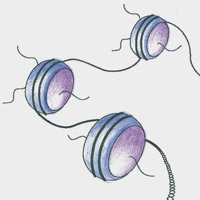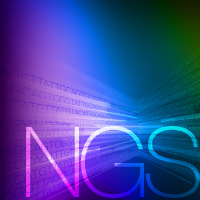To examine the detection of known gene fusion with the two methods, K562 cells were processed using the 10x Chromium system with the Chromium Single Cell 3′ Library & Gel Bead Kit ("10x Genomics 3′DE") or the SMART-Seq ICELL8 application kit workflow ("Takara Bio Full Length"). For all experiments, 10x libraries (single-end reads) were sequenced on a NovaSeq® platform according to 10x recommendations for loading and cycling conditions, and Takara Bio libraries (paired-end reads) were sequenced on a NextSeq® high-output cartridge, based on Illumina's recommended loading and cycling conditions.
Figure 2, Panel A depicts a fusion of NUP214 and XKR3, with junction reads shown in purple and reads spanning transcripts in green. The table in Figure 2, Panel B shows that the 10x method was only able to detect one fusion gene out of five detected using the Takara Bio method. The Takara Bio method's paired-end read counts spanning fusion genes provide additional confirmation. A known BCR--ABL1 fusion was also detected with the Takara Bio method.
![]()

![]()
| Fusion name | Takara Bio Full Length | 10x Genomics 3'DE | Left breakpoint | Right breakpoint | ||
|---|---|---|---|---|---|---|
| Junction* | Spanning* | Junction* | Spanning* | |||
| NUP214--XKR3 | 11 | 20 | 3 | 0 | chr9:131199015:+ | chr22:16808083:- |
| XACT--LRCH2 | 5 | 0 | 0 | 0 | chrX:113938193:- | chrX:115163783:- |
| XACT--LRCH2 | 3 | 0 | 0 | 0 | chrX:113938193:- | chrX:115156667:- |
| C16orf87--ORC6 | 1 | 9 | 0 | 0 | chr16:46824386:- | chr16:46696017:+ |
| C16orf87--ORC6 | 1 | 9 | 0 | 0 | chr16:46824386:- | chr16:46693093:+ |
| BCR--ABL1† | 1 | 1 | n/a | n/a | chr22:23290413:+ | chr9:130854064:+ |
Figure 2. Detection of gene fusions. Data from K562 cells with >85% uniquely mapped reads from a total of ~23M reads. Here, the Takara Bio Full Length method was compared to the 10x Genomics 3'DE (v3) method. *Indicates read counts occurring across the junction ("junction") or spanning either side of the junction ("spanning"). †The known BCR--ABL1 fusion was detected in K562 cells positive for the Philadelphia chromosome using the Takara Bio method. (This sample was not tested using the 10x method.) A K562 cell line negative for the BCR--ABL1 fusion was used to generate the rest of the data.













